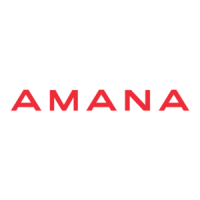16
VIII. Gas Piping
The rating plate is stamped with the model number, type
of gas and gas input rating. Make sure the furnace is
equipped to operate on the type of gas available.
Inlet Gas Pressure
Natural Min. 5.0" W.C., Max. 10.0" W.C.
Propane Min. 11.0" W.C., Max. 13.0" W.C.
Inlet gas pressure must not exceed the maximum value
shown in table above.
The minimum supply pressure must be maintained to
prevent unreliable ignition. In addition, gas input to the
burners must not exceed the rated input shown on the
rating plate. Overfiring the furnace could result in prema-
ture heat exchanger failure.
High Altitude Derate (U.S. Installations Only)
When this furnace is installed at altitudes above 2,000
feet above sea level the furnace input must be derated 4
percent for each 1,000 feet above sea level because the
density of the air is reduced.
In some areas the gas supplier will derate the gas at a rate
of 4% for each 1,000 feet above sea level. It this is not
done, smaller orifices will be required at altitudes above
3,500 feet (nonderated natural gas) or 4,500 feet
(nonderated propane gas).
A different pressure switch is required at altitudes more
than 4,000 feet above sea level. This is required regard-
less of the heat content of the fuel used.
High altitude kits are purchased according to the altitude
and usage of either propane gas or natural gas. Refer to
the Amana distributor for required high altitude kit(s).
Do not derate the furnace by adjusting the manifold
pressure to a lower pressure than specified on the
furnace nameplate. With a lower air density and a lower
manifold pressure at the burner orifice, the orifice will not
supply the proper amount of air into the burner, causing
incomplete combustion of the gas, flashback, and pos-
sible yellow tipping.
Gas Piping
IMPORTANT NOTE: To avoid possible unsatisfactory
operation or equipment damage due to underfiring of
equipment, do not undersize the natural/propane gas
piping from the meter/tank to the furnace. Include all
appliances which may be operated simultaneously when
sizing a trunk line.
The gas pipe supplying the furnace must be properly
sized based on gas flow required, specific gravity of the
gas and length of the run. The gas line installation must
comply with local codes, or in the absence of local
codes, with the latest edition of the National Fuel Gas
Code ANSI Z223.1.
Natural Gas Capacity of Pipe
In Cubic Feet of Gas Per Hour (CFH)
Length of Nominal Black Pipe Size
Pipe in Feet 1/2" 3/4" 1" 1 1/4" 1 1/2"
10 132 278 520 1050 1600
20 92 190 350 730 1100
30 73 152 285 590 980
40 63 130 245 500 760
50 56 115 215 440 670
60 50 105 195 400 610
70 46 96 180 370 560
80 43 90 170 350 530
90 40 84 160 320 490
100 38 79 150 305 460
(Pressure 0.5 psig or less and pressure drop of 0.3" W.C.; Based on
0.60 Specific Gravity Gas)
CFH =
BTUH Furnace Input
Heating Value of Gas (BTU/Cubic Foot)
Connecting Gas Piping - Natural Gas
Refer to Figure 14 for the general layout at the furnace.
The following rules apply:
1. Use black iron or steel pipe and fittings for the
building piping.
2. Use pipe joint compound on male threads only.
Pipe joint compound must be resistant to the action
of the fuel used.
3. Use ground joint unions.
4. Install a drip leg to trap dirt and moisture before it
can enter the gas valve. The drip leg must be a
minimum of three inches long.
5. A 1/8 inch NPT pipe plug fitting, accessible for test
gage connection, must be installed immediately
upstream of the gas supply connection to the fur-
nace.
6. Use two pipe wrenches when making connection to
the gas valve to keep it from turning. The orienta-
tion of the gas valve on the manifold must be the
same as shipped from the factory.
7. Within six feet of the unit, install a manual shutoff
valve between the meter and the unit. If a union is
installed, the union must be downstream of the
manual shutoff valve, between the shutoff valve
and the furnace.
8. Tighten all joints securely.
9. The furnace must be connected to the building
piping by one of the following:
Rigid metallic pipe and fittings.
Semirigid metallic tubing and metallic fittings.
Aluminum alloy tubing must not be used in exte-
rior locations.
Listed gas appliance connectors, used in accor-
dance with the terms of their listing, must be
completely in the same room as the furnace.

